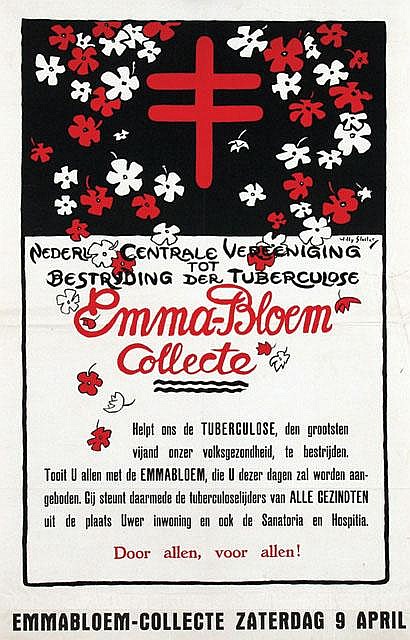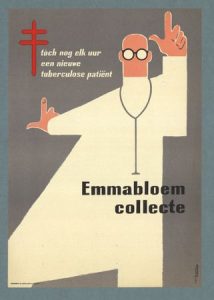A memory from my primary school days: once a year, a nurse from the children’s healthcare centre came by. She wore a blue uniform with a starched white apron. In her big bag she had sandpaper and a bottle of liquid. With that sandpaper, she made a small scratch on our forearms and she dripped the liquid over it. After a week she came back and all the children had to visit her again to see if there had been a reaction (swelling in the skin). If so, the child in question had to be examined further, as he or she might have tuberculosis (TB).
For a very long time, tuberculosis was national disease number 1 in the Netherlands and fighting it was a high priority. To raise money for this fight, the Emmabloem Fundraising was held every year.
Tuberculosis control
In 1903, the Dutch Central Association for the Control of Tuberculosis was founded. Although this association received a subsidy, it also had to raise money through donations. One way was “Emmabloem Fundraising”, during which small flowers made of celluloid were sold. This effort, begun in 1910, was modelled after a similar project in Sweden.
Queen Wilhelmina’s daughter was born on 30 April 1909, and little Juliana’s first birthday was chosen to start the collection. An excellent date, according to the writer of a submitted article in the Society’s magazine: “Is there any day, which will find us patriots in a more grateful and cheerful mood, than this very day?”
The little celluloid flowers were collectively known as Emmabloemen, after the princess’s grandmother, Queen Emma. Thus the name Emmabloem Collecte (bloem = flower, collecte = fundraising) came into being.
The first Emmabloem Fundraising in 1910
The first flower for the collection was a daisy with white petals and an orange heart. The Hague firm Stappers & Co, located at Korte Poten 3, was willing to supply the flowers at no cost. They were made, again for free, at the Eerste Nederlandse Celluloidwarenfabriek A.N. Honig in Koog aan de Zaan. “Powerful ladies’ committees” ran the local fundraising efforts.
The ladies’ committee in The Hague took things well in hand: our city brought in the highest proceeds ( ƒ7675.51), over 1,000 guilders more than Rotterdam and almost 3,000 guilders more than Amsterdam.
Queen Emma
Queen Emma was involved in many charities, but fighting tuberculosis was especially important to her. When she was 11 years old, her sister Sophie, who was four years older, died of tuberculosis. So Emma had experienced up close what this disease could do. After the death of her husband, King William III, Emma served as queen-regent for eight years for her daughter Wilhelma, who was inaugurated as queen when she turned 18.
On the occasion of Emma’s farewell as queen-regent in 1898, the Dutch people raised 300,000 guilders as a national gift to her. She used most of it to have the Netherlands’ first sanatorium built on the Oranje-Nassau’s Oord estate in Wageningen.
Patroness in action
A lot of money was needed for the sanatoria and also for population screening to detect TB. Queen Emma actively participated in fundraising. On 23 March 1933 – a year before her death – for instance, she made a radio speech urging the nation to contribute generously to the cause.
From the same decade is this promotional film in which Emma also plays a role. You might notice that at the beginning there is a specific statement saying that the Emmabloem Collecte is on behalf of tuberculosis sufferers of all denominations. This was important to mention because at that time The Netherlands was still experiencing pillarisation: the vertical separation of people and communities according to religious and attendant political beliefs. ( The various groupings were called pillars, thus the term pillarization.)
Bed Rest
For a very long time, the only known treatment for tuberculosis was rest cures in healthy fresh air. In the 19th century, it had been discovered that people living in the mountains were cured of TB faster than sufferers living elsewhere. That is why sanatoriums were set up in places like Davos in the Swiss Alps. The journey there was long and expensive, so the opening of a sanatorium in the Netherlands offered more people the opportunity to go on a cure. More and more sanatoriums of this kind appeared, including the Zeehospitium in The Hague
TB is a disease caused by a bacterium and it was only with the development of antibiotics that there came a way to treat it without prolonged rest cures. The discovery of streptomycin in 1943 was the real breakthrough. By now, all sanatoria in the Netherlands have either disappeared or been repurposed.
Health care centres
Almost all Dutch cities had health care centres specifically for tuberculosis. The Hague’s centre was located on Waldeck Pyrmontkade from the 1930s to the 1980’s. Very fitting, since Queen Emma was born Princess of Waldeck Pyrmont. Consequently, the other side of this street is called Emmakade. At one time there was a canal or stream in the middle of this street, but that has since been filled in.
I remember that in 1978 I had to go to this health care centre to get tested for TB. I was doing an internship in a school at the time, and you were only allowed to face students if it was certain you did not have TB.
The Emmabloem Collection was held annually until the 1980s. Small paper stamps were also sold to raise funds. These stamps were commonly known as seals, because they could be used to seal envelopes. In later years, the Cross of Lorraine, the international symbol of tuberculosis control, was also used.
In the Netherlands, tuberculosis is pretty much under control, but unfortunately it is still a dangerous infectious disease in other parts of the world. If you want to contribute to the fight against this disease, you can make a donation to the KNCV Tuberculosis Fund.









1 thought on ““Emmabloem” Fundraising”
Very interesting. Thanks